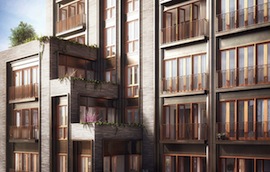Trending
A taste of Denmark on the UWS: Architecture review
Thomas Juul-Hansen's design for Naftali's 210 West 77th shows a deft use of materials -- but lacks pop

The redevelopment of the Upper West Side continues at a brisk pace, with the latest installment arriving at 210 West 77th Street, Between Amsterdam Avenue and Broadway.
This new residential building, which is being developed by the Naftali Group, will take the place of an ugly Hertz rental garage that is still standing. The structure is slated to rise 18 stories and contain 25 units priced between $4.9 million and $12 million.
The project’s architect is Thomas Juul-Hansen, a young Danish designer. Juul-Hansen’s design style is somewhat similar to an even younger Danish architect, Bjarke Ingels, who is completing a massive project on the Far West Side, at 57th Street and the Hudson River. But whereas Ingels is far more radical in his forms, torking a pyramid and then gouging a big chunk out of its center, Juul-Hansen is more conservative and decorous.
Renderings of the structure show that the façade on the 77th Street building consists of a series of plates that shift across its surface, two bays wide to the west and one bay wide to the east, with two far thinner lines interposed between them. At the base is a slightly inset entrance, which almost looks too pedestrian for a tall Manhattan residential building.
Indeed, its plant-covered wall and its wooden doors and windows seem more in keeping with a private house. Between the 12th and the 15th floors, each of the surface plates is recessed in a set-back, rising from west to east.
Although I freely admit that I probably would never have drawn this connection if I didn’t know that Juul-Hansen was Danish, his placing of wooden accents around his windows and setting them in a context of brownish stone at the edges of the façade reflects a certain Nordic sensitivity to materials. That aesthetic goes back to the earliest days of the Bauhaus and architects like Alvaar Alto.
To judge from the renderings, the details of the building will be more prepossessing than the façade as a whole. But the overall design does not attain the presence of this architect’s paired residential structures at 505 West 19th Street, near the High Line. Those buildings deserve a column to themselves.




